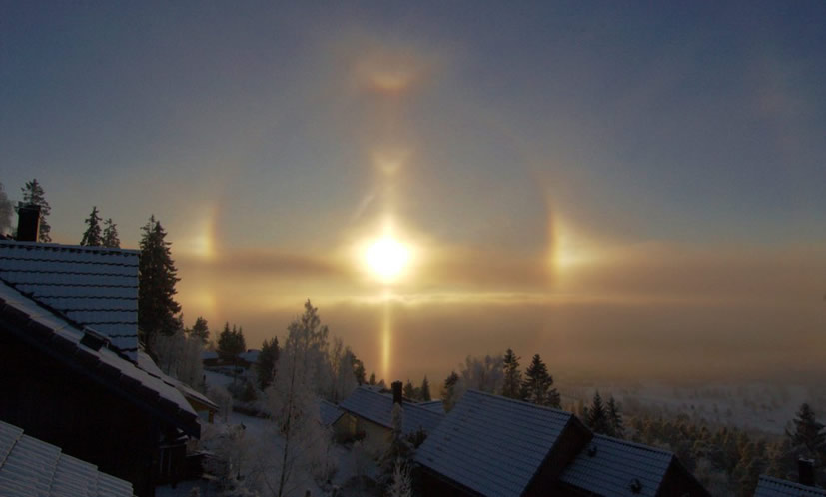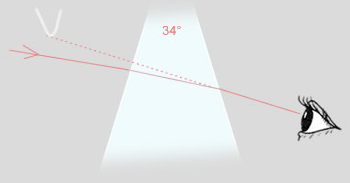Moilanen Arc
Exploring the Enigmatic Moilanen Arc
The Moilanen arc, named after its discoverer Jarmo Moilanen of Finland, is a rare and intriguing atmospheric optical phenomenon. This peculiar arc takes the shape of a "V" and is typically observed above the sun and halfway to the upper tangent arc or 22° halo. While it has been seen during natural halo displays, it is more commonly observed in the diamond dust formed downwind of ski-slope snow machines.
Unraveling the Mystery
The Oslo display of December 16, 2007, provided a remarkable opportunity to capture the Moilanen arc in all its glory. Photographer Steinar Midtskogen managed to capture this elusive phenomenon through his webcam. Although the display was visible over a wide area, the Moilanen arc only appeared in Midtskogen's images. Interestingly, a ski-slope with operating snow machines was located approximately 1.5 km away, suggesting a possible connection between the artificial crystals produced by the machines and the appearance of the arc.
Crystallographic Improbabilities
Simulating the Moilanen arc is relatively straightforward using prisms with an apex angle of 34° aligned in a specific manner. However, identifying the exact ice crystals responsible for its formation has proven to be a challenging task. The crystallographic properties required to produce the Moilanen arc, such as an ice interfacial angle of 34° and the orientation of an isolated prism, are highly improbable. Furthermore, no other associated halos, such as a lower M-arc or ones from other interfacial angles, have been observed, further limiting the possibilities for crystal sources.
The Quest for Answers
Despite extensive efforts by Finnish observers to photograph diamond dust displays and sample crystals from them, the true origin of the Moilanen arc remains unknown. This enigmatic halo continues to defy explanation and remains one of the many unexplained atmospheric optical phenomena. Researchers and halo enthusiasts continue their quest to unravel the mysteries of this captivating arc.
Diamond Dust and Optically Perfect Crystals
Diamond dust, the precursor to the Moilanen arc, forms when snow machines eject small seed nuclei into the air. These nuclei provide a surface for ice crystals to grow from the condensation of atmospheric moisture. The growth process occurs over distances ranging from hundreds of meters to several kilometers downwind. Interestingly, the snow machines that produce the most remarkable halos often utilize enzymes as crystal growth nuclei. The resulting crystals share the same structure, forms, and habits as naturally occurring ones but possess near-optical perfection, allowing them to generate rare and exquisite halos.
The Unpredictability of Nature
The Moilanen arc serves as a reminder of the intricate and unpredictable nature of atmospheric optics. Despite advances in our understanding of these phenomena, there are still mysteries that elude us. The presence of this peculiar "V" shaped arc highlights the complexity of crystal formation in the atmosphere and the interplay between natural and artificial processes. It continues to captivate researchers and photographers alike, inspiring further exploration and investigation.
A Spectacular Sight
Witnessing the Moilanen arc during a halo display is truly a breathtaking experience. Its distinctive shape adds a touch of uniqueness to an already mesmerizing celestial spectacle. While its occurrence may be rare, it serves as a reminder of the wonders that can be found in the skies above. So, keep your eyes peeled during halo displays and you may just catch a glimpse of this elusive phenomenon, adding another chapter to the ongoing saga of atmospheric optical marvels.

The "V" shaped arc above the sun and half way to the upper tangent arc/22° halo is the rare Moilanen arc. Imaged by Steinar Midtskogen (webcam) during the Oslo display of December 16, 2007. ©Steinar Midtskogen, shown with permission.
The Moilanen arc is named after its discoverer, halo expert Jarmo Moilanen of Finland.

The rare “V” shaped arc, varying in position with solar altitude, has been observed during natural halo displays but is seen more often in the diamond dust formed downwind of ski-slope snow machines. The Oslo display (above) was seen and photographed over a wide area but the Moilanen arc only shows in Steinar Midtskogen's images. A ski-slope with operating machines was 1.5 km away and while the main halo display was natural, the M-arc could have originated from machine crystals**.The arc is easily simulated using prisms of apex angle 34° aligned as shown and taking all rotational positions about a vertical axis. Identifying the ice crystals that actually produce it is quite another matter. An ice interfacial angle of 34° is crystallographically improbable as would be the orientation of an isolated prism. Furthermore, no other associated halos, for example a lower M-arc or ones from other interfacial angles present, have been observed which further limits the crystal possibilities. Despite the hard work of Finnish observers in photographing diamond dust displays and sampling crystals from them, the crystal source of the arc remains unknown. It is one of the unexplained halos.
** Snow machines eject small seed nuclei into the air on which halo forming ice crystals subsequently grow from condensation of atmospheric moisture. The growth occurs over hundreds of metres to several kilometres downwind. The snow machines that make the best halos use enzymes as a crystal growth nuclei. The crystals have the same structure, forms and habits as naturally occurring ones. However, for reasons not yet understood (type of nucleate, atmospheric conditions), they can be near optically perfect and generate rare halos.
Note: this article has been automatically converted from the old site and may not appear as intended. You can find the original article here.
Reference Atmospheric Optics
If you use any of the definitions, information, or data presented on Atmospheric Optics, please copy the link or reference below to properly credit us as the reference source. Thank you!
-
<a href="https://atoptics.co.uk/blog/moilanen-arc/">Moilanen Arc</a>
-
"Moilanen Arc". Atmospheric Optics. Accessed on November 21, 2024. https://atoptics.co.uk/blog/moilanen-arc/.
-
"Moilanen Arc". Atmospheric Optics, https://atoptics.co.uk/blog/moilanen-arc/. Accessed 21 November, 2024
-
Moilanen Arc. Atmospheric Optics. Retrieved from https://atoptics.co.uk/blog/moilanen-arc/.